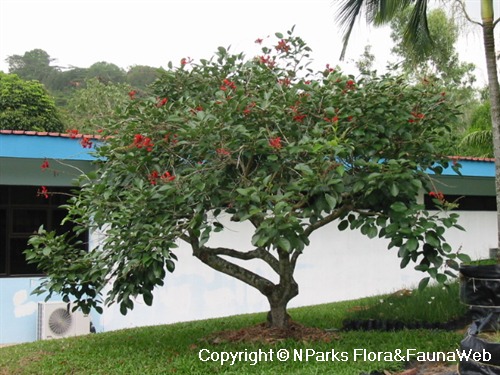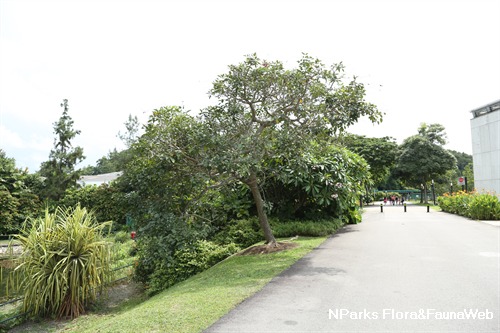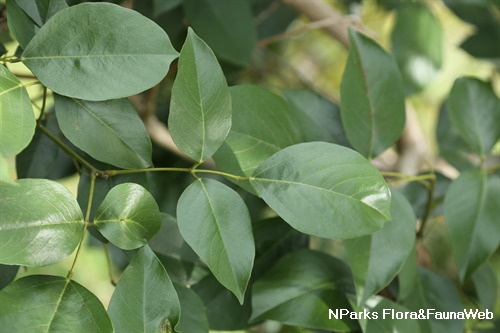.jpg)
Back
Erythrina fusca Lour.
| Family Name: | Fabaceae (Leguminosae) |
| Synonyms: | Erythrina caffra, Erythrina viarum, Erythrina ovalifolia, Erythrina glauca |
| Common Name: | Coral Tree, Chengkring, Purple Coral Tree, Coral Bean Tree, Lucky Bean Tree, Bucayo, Swamp Erythrina, Kaffirboom, Cape Kaffirboom, Chekring |
Name
Classifications and Characteristics
| Plant Division | Angiosperms (Flowering Seed Plants) (Dicotyledon) |
|---|---|
| Plant Growth Form | Tree |
| Lifespan (in Singapore) | Perennial |
| Mode of Nutrition | Autotrophic |
| Maximum Height | 10 m to 15 m |
| Tree or Palm – Trunk Diameter | 1 m |
Biogeography
| Native Distribution | Central America, South America |
|---|---|
| Native Habitat | Terrestrial (Coastal Forest, Riverine), Shoreline (Sandy Beach) |
| Preferred Climate Zone | Tropical, Sub-Tropical / Monsoonal |
Description and Ethnobotany
| Flowers | Flowers have bright red or peach fleshy petals. The inflorescence is a raceme (stalked flowers held along one main axis). |
|---|---|
| Fruit | Fruits are flattened woody pods (15-20 cm long, 2 cm wide). The pod has a velvet-like texture and is pointed at the apex. Each pod contains 3 - 15 ellipsoid seeds (1.2 cm long). |
| Others - Plant Morphology | Growth Form: Deciduous, medium-sized tree with a round crown. Habitat: Occurs in tropical or subtropical lowland forests at altitudes from 0 - 2,000 m. Found near streams, swamps and seashores. Trunk: Short trunk is 1 m dbh (diameter at breast height which is ~1.4 m). Trunk and branches bear short prickles (1 - 2 cm long). Flaky bark is brownish grey or brown. Foliage: Leaf is trifoliate, consisting of 3 ovate leaflets (8 - 14 cm long, 7 - 12 cm wide). The terminal leaflet is slightly larger than the lateral leaflets. Propagation: Propagate by seed or large cuttings (2 m long, 6 - 10 cm wide). Cuttings need to be placed in very moist soil for rooting. |
| Cultivation | Compared to other Erythrina sp, this species is relatively easy-to-grow. This species will not grow well in shade. It is susceptible to the stem borer Betocera sp., a ring borer from the Family Lecanidae and fungi (eg., Calostibe striipora). |
| Etymology | The genus "Erythrina" is derived from the Greek word for red ("eruthros"). The reference is to the red blossoms of many Erythrina spp.. The species epithet "fusca " is Latin for brownish grey. It may refer to the bark colour. |
| Ethnobotanical Uses | Edible Plant Parts : Edible Leaves Food (Fruit or Vegetable) Others: Food: In Java, young leaves are consumed as a vegetable. Medicine: In Malaysia, the bark is used as a poultice to treat wounds. A decoction prepared from the roots is consumed or applied externally to treat beri-beri (a disease caused by a thiamine deficiency) . Other: This species can improve soil quality by adding nitrogen, because it has a mutually beneficial relationship with nitrogen-fixing bacteria. Farmers plant cacao and coffee in the shade of this tree to benefit from the added nitrogen. The seeds are poisonous and may be used as an insecticide against the American cockroach (Periplaneta americana). |
Landscaping Features
| Desirable Plant Features | Ornamental Flowers |
|---|---|
| Landscape Uses | Coastal |
| Usage Hazard - Cons | Spines/Thorns - Stem/Branch, Spines/Thorns - Trunk, Toxic Upon Ingestion |
Fauna, Pollination and Dispersal
| Pollination Method(s) | Biotic (Fauna) (Vertebrates (Bird), Associated with: May be pollinated by hummingbirds in foreign countries.) |
|---|---|
| Seed or Spore Dispersal | Abiotic (Water), Biotic (Fauna) |
Plant Care and Propagation
| Light Preference | Full Sun |
|---|---|
| Water Preference | Moderate Water |
| Plant Growth Rate | Moderate |
| Rootzone Tolerance | Fertile Loamy Soils, Well-Drained Soils, Poor Infertile Soils, Waterlogged Soils (Drains Site), Saline Soils / Salt Spray |
| Propagation Method | Seed |
| Planting Distance | 6 m to 12 m |
Foliar
| Mature Foliage Colour(s) | Green |
|---|---|
| Mature Foliage Texture(s) | Smooth |
| Foliar Type | Compound (Trifoliate) |
| Foliar Arrangement Along Stem | Alternate |
| Foliar Shape(s) | Non-Palm Foliage (Ovate) |
| Foliar Venation | Pinnate / Net |
| Foliar Margin | Entire |
| Foliar Apex - Tip | Acute |
| Foliar Base | Acute, Rounded / Obtuse |
| Typical Foliar Area | Macrophyll ( 182.25cm2 - 1640.25 cm2 ) |
| Leaf Area Index (LAI) for Green Plot Ratio | 3.0 (Tree - Intermediate Canopy) |
Non - Foliar and Storage
| Trunk Type (Non Palm) | Woody |
|---|---|
| Bark Colour(s) | Brownish grey, brown |
| Mature Bark Texture | Peeling / Flaking / Papery |
| Root Type | Underground (Tap Root) |
Floral (Angiosperm)
| Flower & Plant Sexuality | Bisexual Flowers |
| Flower Colour(s) | Orange, Red |
|---|---|
| Flower Symmetry | Bilateral |
| Inflorescence Type | Raceme |
| Flowering Habit | Polycarpic |
Fruit, Seed and Spore
| Mature Fruit Colour(s) | Brown |
|---|---|
| Fruit Classification | Simple Fruit |
| Fruit Type | Dehiscent Dry Fruit , Legume / Pod |
Image Repository
Others
| Master ID | 1586 |
|---|---|
| Species ID | 2879 |
| Flora Disclaimer | The information in this website has been compiled from reliable sources, such as reference works on medicinal plants. It is not a substitute for medical advice or treatment and NParks does not purport to provide any medical advice. Readers should always consult his/her physician before using or consuming a plant for medicinal purposes. |

.jpg)
.jpg)






.jpg)